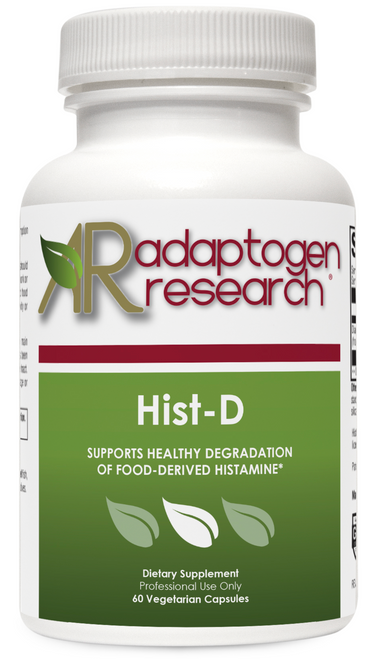- Home
- Adaptogen Research
- Adaptogen Research
- Hist-D | 60 Vegetarian Capsules | Adaptogen Research
Hist-D | 60 Vegetarian Capsules | Adaptogen Research
Product Description
Hist-D is a patented enzyme formula containing diamine oxidase —the main enzyme responsible for the degradation of ingested histamine. This enzyme has been clinically tested and found to break down food-derived histamine in the digestive tract. Diamine oxidase is not absorbed and does not have systemic activity. Hist-D does not manage or address antibody-related or IgE-related food allergies.*
Hist-D:
Directions
Take one to two capsules no more than 15 minutes before the consumption of histamine-rich foods, or take as directed by your healthcare professional. Consult your healthcare professional prior to use. Individuals taking medication should discuss potential interactions with their healthcare professional. Avoid if allergic to pork or any other ingredient. Hist-D is NOT EFFECTIVE for symptoms of immune-related food allergies, such as peanuts, shellfish, etc., or for gluten intolerance due to sensitivity or celiac disease. Do not use if tamper seal is damaged.
Histamine is a bioactive or “vasoactive” amine produced in the body in response to an injury or foreign substance. It has an
array of physiological effects, including increasing blood supply to specific sites in the body. In addition, histamine is involved
in the immune response, regulation of gastric acid, permeability of blood vessels, contraction of muscles, and the normal
response to inflammation.[1] The highest concentrations of histamine in the body are found in the gastrointestinal tract, lungs,
and skin, with lesser amounts in the brain and heart.*
Histamine is not only produced in the body but is also present in many fermented foods, such as sauerkraut, sausage,
cheese, yogurt, and alcoholic beverages. Tuna, olives, spinach, eggplant, avocados, tomatoes, cherries, and citrus fruits
are other histamine-containing foods. Despite their absence of histamine, some foods, such as berries, tea, and a variety of
spices, stimulate the endogenous production of the amine due to their benzoate content. In addition, microbial fermentation
can convert the histidine in high-protein foods to histamine so that the histamine content of food can increase over time.*[1]
Histamine/DAO balance Endogenous and exogenous histamine must be broken down in order to maintain homeostasis
and histamine balance. The enzyme diamine oxidase (DAO) degrades histamine by converting it from 2-(4-imidazolyl)-
ethylamine to the inactive metabolite imidazole acetaldehyde.[2] The active ingredient in Hist-D is porcine-derived diamine
oxidase, and research suggests that DAO derived from porcine kidney appears to have identical action to DAO derived
from porcine intestine.[3] In humans and other mammals, DAO is found in high concentrations in the gastrointestinal mucosa.
Animal studies suggest that circulating DAO may be a marker for mucosal integrity and maturity.[4] Certain drugs may affect
histamine balance in the body by promoting histamine release or inhibiting DAO.*[2]
Histamine Tolerance Histamine tolerance may not be the same for everyone. Results of a double-blind, placebo-controlled
crossover study suggest that tolerance to histamine can vary from individual to individual.[5] Total body histamine load must
be considered when evaluating histamine tolerance, and a balance between histamine and DAO appears to be crucial
to maintaining skin, rhinoconjunctival, and gastrointestinal health.[2,6] Genetic and environmental factors may interact to
influence DAO expression. Ongoing research addresses the role that genetic variations may play in individual differences
in DAO metabolism, and serum activity was significantly associated with seven single nucleotide variations within the DAO
gene.[7,8] Histamine tolerance may be reflected in detailed questionnaires, food intake logs, trial with low-histamine diet, and
measurement of DAO and histamine.*[9,10]
Histamine tolerance and its manifestation may vary from organ to organ as well. A study of 39 patients suggested that intake
of DAO produced a statistically significant reduction in symptoms associated with exogenous histamine ingestion, although
single symptoms were not found to be reproducible.*[11]
Ultimately, diminished serum DAO levels appear to be associated with changes in histamine degradation and serum histamine
levels.[10] Although the mechanism of histamine degradation is uniform throughout the body, Hist-D only addresses excess
exogenous histamine found in the folds, villi, and microvilli of the small intestine. Hist-D is not absorbed and therefore does
not have systemic activity. A two-capsule dose of Hist-D contains 20 mg of vitamin C and 20,000 HDU (histamine degrading
units) from diamine oxidase. Hist-D is NOT EFFECTIVE for symptoms of immune-related food allergies, such as peanuts,
shellfish, etc.*
 Loading... Please wait...
Loading... Please wait...